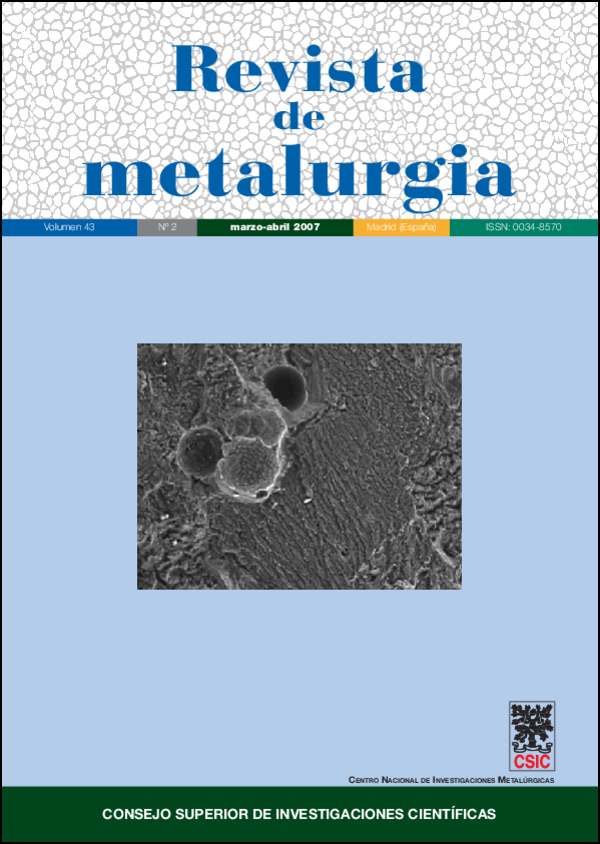Initial stages of indoor atmospheric corrosion of electronics contact metals in humid tropical climate: tin and nickel
DOI:
https://doi.org/10.3989/revmetalm.2007.v43.i2.56Keywords:
Indoor atmospheric corrosion, Tin, Nickel, Tropical marine climateAbstract
Samples of electrolytic tin and nickel have been exposed for 1 to 12 m in indoor environment, inside a box (rain sheltered cabinet), placed in tropical humid marine-urban climate, as a part of Gulf of Mexico. The corrosion aggressiveness of box has been classified as a very high corrosive, based on the monitored chlorides and SO2 deposition rates, and the Temperature/Relative Humidity air daily complex. The annual mass increasing of nickel is approximately twice higher than its values of mass loss (C). The relation between nickel mass loss or increasing and time of wetness (t) of metal surface is linear and does not obey the power equation C = A tn, which has be found for tin. The SEM images reveal a localized corrosion on nickel and tin surfaces. XRD detects the formation of SnCl2.H2O as a corrosion product. Within the time on the tin surface appear black spots, considered as organic material.
Downloads
References
[1] E. White, G. Slenski And B. Dobbs, Corrosion, Vol. 13, ASM Handbook, J. R. Davis (Ed.), ASM International, USA, 1987, pp. 1113-1126.
[2] R. Baboian, Corrosion Tests and Standards, Application and Interpretation, 2nd ed., R. Baboian (Ed.), ASTM International, West Conshohocken, PA, USA, 2005, pp. 754-761.
[3] R. P. Frankenthal, Uhlig’s Corrosion Handbook, 2nd ed., R. Winston (Ed.), John Wiley & Sons, Inc., N.Y., USA, 2002, pp. 941- 947.
[4] C. Leygraf, Corrosion Mechanism in Theory and Practice, P. Marcus and J. Oudar (Eds.), Marcel Dekker, Inc, N. Y., USA, 1995, pp. 447-455.
[5] R. Schubert, A. Veca And E. Fischer, Corrosion of Electronic and Magnetic Materials, Ph. J. Peterson (Ed.), ASTM STP 1148, ASTM International, West Conshohocken, PA, USA, 1992, pp.1-10.
[6] D. W. Rice, R. J. Cappell, W. Kinsolving And J. J. Laskowski, J. Electrochem. Soc. 127 (1980) 891-901. doi:10.1149/1.2129780
[7] T. Sasaki, T. Kanagawa, T. Ohtsuka And K. Miura, Corr. Sci. 45 (2003) 847-854. doi:10.1016/S0010-938X(02)00151-8
[8] M. Pourbaix, Atlas of Electrochemical Equilibria in Aqueous Solutions, NACE International, Houston, TX, USA, 1974, p.477.
[9] S. Zakipour And C. Leygraf, J. Electrochem. Soc. 133 (1986) 21-30. doi:10.1149/1.2108528
[10] J. Tidblad And V. Kucera, Report 26, Swedish Corrosion Institute, Stockholm, Sweden, 1998.
[11] E. Sikora And D. D. Macdonald, Electrochem. Acta 48 (2002) 69-77. doi:10.1016/S0013-4686(02)00552-2
[12] D. W. Rice, P. B. Phipps And R. Tremoureux, J. Electrochem. Soc. 127 (1980) 563-568. doi:10.1149/1.2129712
[13] D. PERSSON AND C. LEYGRAF, J. Electrochem. Soc. 139 (1992) 2243-2249. doi:10.1149/1.2221209
[14] D. PERSSON AND C. LEYGRAF, J. Electrochem. Soc. 142 (1995) 1468-1477. doi:10.1149/1.2048598
[15] T. E. Graedel And C. Leygraf, J. Electrochem. Soc. 147 (2000) 1010-1014. doi:10.1149/1.1393305
[16] E. Johansson, C. Leygraf And B. Rendahl, Br. Corr. J. 33 (1998) 59-66.
[17] J. Tidblad, V. Kucera And A. Mikhailov, UN/ECE Report 30, Swedish Corrosion Institute, Stockholm, Sweden, 1998.
[18] ANSI/ISA-SP71, Airborne Contaminants Instrument Society of America, Research Triangle Park, NC, USA, 1997.
[19] M. Forslund, J. Majoros, C. Leygraf, J. Electrochem. Soc. 144 (1997) 2637-2642. doi:10.1149/1.1837876
[20] E. Johansson, C. Leygraf, Br. Corros. J. 34 (1999) 27-33.
[21] L. Veleva L., G. Pérez G., M. Acosta, Atmos. Environ. 31 (1997) 773-776. doi:10.1016/S1352-2310(96)00232-4
[22] ISO Standard 1844-04, ISO, Geneve, Switzerland, 2004.
[23] ISO Standard 9223-92, ISO, Geneve, Switzerland, 1992.
[24] ISO Standard 9225-92, ISO, Geneve, Switzerland, 1992.
[25] L. Veleva, L. Maldonado, Br. Corros. J. 33 (1998) 53-57.
[26] I. Odnevall, C. Leygraf, J. Electrochem. Soc. 144 (1997) 3518-3525. doi:10.1149/1.1838043
Downloads
Published
How to Cite
Issue
Section
License
Copyright (c) 2007 Consejo Superior de Investigaciones Científicas (CSIC)

This work is licensed under a Creative Commons Attribution 4.0 International License.
© CSIC. Manuscripts published in both the printed and online versions of this Journal are the property of Consejo Superior de Investigaciones Científicas, and quoting this source is a requirement for any partial or full reproduction.All contents of this electronic edition, except where otherwise noted, are distributed under a “Creative Commons Attribution 4.0 International” (CC BY 4.0) License. You may read here the basic information and the legal text of the license. The indication of the CC BY 4.0 License must be expressly stated in this way when necessary.
Self-archiving in repositories, personal webpages or similar, of any version other than the published by the Editor, is not allowed.
















